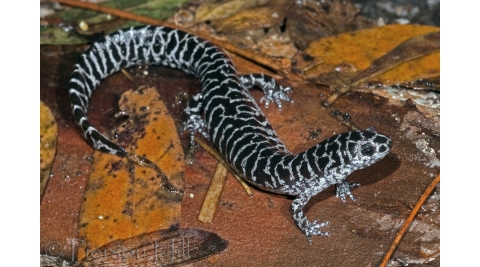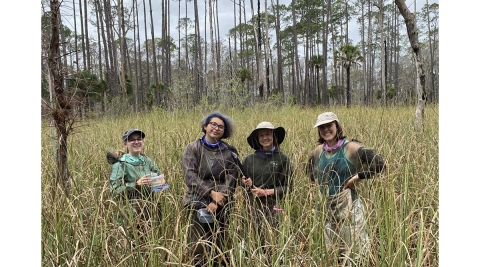St. Marks, Florida – The St. Marks National Wildlife Refuge is under the climate gun as Mother Nature unleashes all manner of temperature, precipitation, and storm havoc on the popular preserve along the Gulf Coast. Sadly, the animals that once depended upon steady weather and predictable tides suffer the brunt of the climatic fury. But the refuge isn’t ready to wave the white flag just yet.
It’s fighting back.
St. Marks adds thousands of acres to its northern flank, further inland and away from the Gulf of Mexico. It plants endangered-species-friendly, long-lived longleaf pines. It prescribes fire to weed out invasive plants which, in turn, protects carbon-storing big trees. It delays the beginning of the annual Monarch Butterfly Festival to better accommodate the insects hammered by the warming world. And it takes extraordinary steps to save the frosted flatwoods salamander, a small and rare amphibian whose existence depends on a handful of ponds endangered by climate change climate change
Climate change includes both global warming driven by human-induced emissions of greenhouse gases and the resulting large-scale shifts in weather patterns. Though there have been previous periods of climatic change, since the mid-20th century humans have had an unprecedented impact on Earth's climate system and caused change on a global scale.
Learn more about climate change .
“The species is in decline, so it’s going through a bit of an extinction vortex,” said Chloë Dubben, a biological technician at the refuge who’s trying to save the sallies. “And that’s where all the problems start to compound.”
Warmer and weirder weather
The Big Bend, where peninsular Florida curls into Panhandle Florida, would seem largely immune to the vagaries of a steadily warming world. The series of wildlife refuges, state parks, national forests, and other protected lands provide a bulwark against the rising Gulf waters and salty storm surge. The wetlands also buffer Tallahassee from hurricanes, slowing the high winds and ferocious waves that erode the coastline. The state capitol, after all, sits a relatively high 200 feet above sea level. Miami, by comparison, rises barely above six feet.
Looks, though, deceive. The average temperature across the Big Bend has risen three degrees since 1970 and keeps going up. The Gulf, too, has risen, up a foot in the last century, according to Climate Central. As the Gulf warms, it fuels storms and hurricanes which get nastier and dump more water inland which causes ever-worse flooding. So-called “weather weirding” – massive deluges of rain interspersed with severe droughts – are hallmarks of climate change.
Hurricane Michael in 2018 devastated the Florida Panhandle with winds topping 155 mph, rainfall cresting 10 inches, and a 10-foot storm surge near St. Marks. Saltwater flowed well inland, inundating many freshwater ephemeral ponds beloved by the salamanders. The sallies, by then, though, were already in trouble.
They once filled ponds across the longleaf pine forests of the Southeastern coastal plain. In 2009, 25 salamander populations were tallied. In 2015, only nine remained, most in Florida. The U.S. Fish and Wildlife Service said “the outlook for this species is so bleak” that it recommends reclassifying the species from threatened to endangered.
In Georgia, only one breeding pond remains at Fort Stewart. The rest are found at St. Marks and the nearby Apalachicola National Forest. Their decline mirrors the regional trend: In 2006, 52 ponds on the refuge were occupied by salamanders. In 2015, flatwoods salamander larvae were documented in only 11 ponds.
This year? Five ponds.
“And we’ve only documented about 65 larvae total which is low,” said Emma Jones, a St. Marks intern who was conducting salamander surveys on the refuge in March with three other recent college graduates. “We haven’t seen any larvae since last week. It is definitely a concern when we’re not getting the amount of larva as in previous years.”
Each day Jones and colleagues – Heather Poyner, Olive Chen, Ella Shively and Tessa Ricker – drove from pond to pond counting salamander larvae. They slogged through shin-high muck and chest-high sawgrass towards pink flags that marked the location of minnow traps. Openings on either end allowed a veritable feast of aquatic life to enter, though not exit, the plastic trap. Baby sunfish. Snails. Snakes. Newts. Green tree frogs. Dragonfly larvae. The interns, though, catalogued few salamander larvae. Only two more would be found during the remainder of the 2022 sampling season.
“The sallies need such specific rainfall patterns to be able to reproduce, and climate change, or ‘weather weirding’ events, make years that they can reproduce well fewer and far between,” said Dubben who manages the interns. “It seems like it’s either super dry or super wet with not a whole lot of anything in between. The last couple of weeks you’d be driving down the road and water would be splashing over the hood of the truck.”
Disappearing habitat
The salamanders’ habitat disappeared along with the longleaf pine. The mighty pines, home to red-cockaded woodpeckers, gopher tortoises, eastern indigo snakes, and a multitude of other threatened and endangered species, once covered 90 million acres near the coast that stretched from Virginia to Texas. Fire routinely rolled across the forested plain, clearing the underbrush and rejuvenating the grasses, forbs, and shrubs that sustain wildlife. Loggers, though, decimated the longleaf pine. In its place, rows of fast-growing slash and loblolly pines were planted. Roughshod harvesting methods further trashed the delicate, seasonal ponds that sallies depend upon for breeding. The changing climate has proved deadly to salamanders too.
The ponds retain the salty water left behind by hurricanes and storm surges. Salinity kills the vegetation (grasses and forbs) salamanders need for egg-laying while introducing woody vegetation (sawgrass, gallberry) in the nearby flatwoods where they spend most of their lives.
Weird weather doesn’t help either. Greg Titus, the refuge’s fire management officer, says droughts in 1985, 1998, 2001-02, 2007, and 2011-12 led to wildfires. And then came the rains in unpredictable and massive amounts that messed with the ponds and the adjoining edge-lands where salamanders lay their eggs.
Last fall, for example, the water levels in St. Marks’ ponds were “unusually high,” according to Dubben, when the sallies laid their eggs. Then, nothing – no significant rain until mid-January when a storm dumped six inches of rain. The ponds overflowed into the breeding areas which, finally, benefited the eggs. By then, though, it was too late. Most of the amphibians’ eggs didn’t hatch. Dubben believes those were the only eggs to hatch this year in the wild.
In captivity, it was a different matter. Dubben and crew collect salamander larvae, relocate them to Service-protected cattle tanks where they metamorphose into baby sallies before being returned to their ponds. So-called head-starting the larvae greatly increases chances for survival. The Atlanta-based Amphibian Foundation, for example, successfully bred a frosted flatwoods salamander in captivity for the first time in February.
More work needs to be done, though, to save the sallies.
Save the sallies
The interns parked along the levee road well beyond the mama and baby alligators lolling in a ditch filled high with tea-colored water. The large pond with pink ribbons was fringed with slash pines, cypress knees, and saw palmettos. Underneath lay a veritable jungle of sawgrass, gallberry, and other woody vegetation inhospitable to salamander larvae. Not surprisingly, the interns didn’t find any larvae in Pond 2017.
“A lot of these areas need to be burned,” Poyner said. “The vegetation is just not right for sallies. So, the habitat is not great. It's really diminished by sawgrass and other salt-tolerant plants which are not supposed to be here.”
The Service – given the seasonal and climatic restraints imposed by ever-weirder weather – undertakes a vigorous schedule of prescribed fire to clear out unwanted vegetation around ponds so salamanders can lay their eggs. Titus, the fire manager, burns about a fourth of St. Marks’ 82,000 acres every year. Work crews also saw, chop, mow, thin, and apply chemicals to the unwanted trees and plants. Increasingly, the work is undertaken on the refuge’s northern side – furthest from the rising Gulf.
St. Marks bought, or received via donation, 15,000 acres along the refuge’s northern edge from the Sam Shine Foundation and The Nature Conservancy over the last decade. Ducks Unlimited owns another 1,300 acres north of the refuge boundary which, someday, will become refuge land. In all, maybe a dozen new ponds could provide prime salamander habitat.
“Hurricane Michael was a wake-up call for us because we’d never had saltwater come up that high before,” said Terry Peacock, the refuge manager. “It came up almost to the visitor center and most of our ponds are below the center. So, as the sea levels rise, we’re acquiring more lands to the north.”
Three ponds in the newly acquired north have been restored. Tens of thousands of climate-change-averse longleaf pines will be planted, boosting St. Marks’ total longleaf acreage beyond 15,000. (Another 30,000 acres hold a mix of longleaf and slash pine which is also suitable habitat for a variety of endangered species.)
Will the salamanders survive?
“I don’t think they’d be fast enough to get away from sea level rise,” Dubben said. “We’d have to physically pick them up and move them north. We’d have to translocate them. But the further north the better.”






